Both Yunnan and Tibet are plateaus but with different culture and nature. Yunnan, the Province of Colorful Clouds, has 26 ethnic groups, including the famous Naxi and Tibetan. While the majority of Tibet's population are Tibetan people. A trip connect Yunnan with Tibet is a very interesting experience. You will witness the natural wonders, experience exotic ethnic culture... This is the tour! You will finish your trip at the Nepal Tibet border - Gyirong Port where you can easily get to Kathmandu, the capital city of Nepal.
Highlights of this tour:
- Visit all the highlights and hidden gem of Lijiang in brief two days, including Jade Dragon Snow Mountain, Baisha Mural Painting, Black Dragon Pool Park, Tiger Leaping Gorge, etc.;
- Enjoy heavenly landscape and cultural atmosphere in the real Shangri-la - sacred monastery, rugged plateau lakes and forest, etc.;
- Witness the magnificent power of Tibetan Buddhism in Tibet by visiting the most influential monasteries and palace in Tibet - Jokhang Temple, Potala Palace, Palcho Monastery, etc.;
- Realize your dream to conquer the world's highest peak - Mount Everest.
Tour Brief Information
- Tour price: from
- Tour code: TD-YT-12
- Tour Type: Private Customizable Tour Package
- Destination: Kunming / Lijiang / Shangri-La / Lhasa / Shigatse / Mount Everest / Gyirong / Kathmandu
- Duration: 12 days and 11 nights
- Departure: Flexible
- Travel Theme:






- Best Time:




- Physical Level
- Tour Pace
- Max Altitude
5,200m
- Itinerary Details
- Price Guide & Booking
- Trip FAQs
- Reviews
- Make an Enquiry
Your tour - at a glance
Day 1~2 Arrival & Kunming Tour Tour
Day 3~4 Lijiang & Tiger Leaping Gorge
Day 5 Shangri-La Tour
Day 6~8 Lhasa Tour
Day 9~11 Lhasa - Gyantse - Shigatse - Everest
Day 12 Gyirong - Kathmandu
Itinerary Details - Day by Day
Day 1 Kunming Arrival
Welcome to Kunming! Upon arrival at the airport or train station, your tour guide will meet you and escort you to your hotel. For the rest of the day you will be free to walk around in the fascinating spring city on your own.
Day 2 Kunming - Lijiang ( B )
After breakfast, drive about 85km to the renowned UNESCO World Nature Heritage - Stone Forest, a huge collection of grey limestone pillars. Being weather-beaten for millions of years, the stones turn intricate formations and precious geological relics. There are many interesting legends about Stone Forest. The most famous one goes like that the immortals shattered a mountain into a labyrinth when the lovers who were seeking privacy. In fact, apart from stone forests, the whole scenic area presents various views, including karst caves, waterfalls, underground rivers etc. Walking into the maze and feasting on the natural masterpieces, you will have a compulsive desire to make a complement on uncanny workmanship of nature.
After the sightseeing, drive to the airport to take your flight to Lijiang.
-
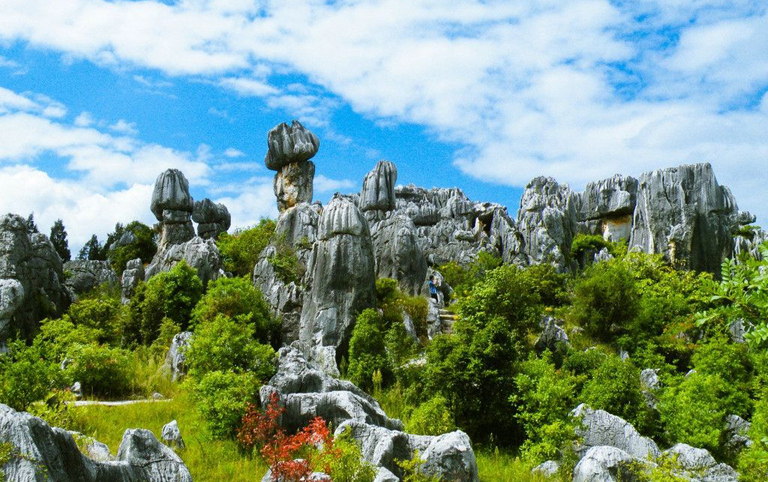 Walk into the Stone Forests and enjoy the odd-shaped stones
Walk into the Stone Forests and enjoy the odd-shaped stones
Day 3 Lijiang ( B )
Today, your first stop is Jade Dragon Snow Mountain with 13 peaks shaping like a lying jade dragon. It soars to 5596m above the sea and presents breathtaking scenery and pristine glaciers all the year round. On route, you will encounter 2000-year-old Ganhaizi with luxurious sorts of plants. In the mountain, the beautiful Blue-Moon Valley will give you a visual treat by its blue or milky water depending on the weather. For further sightseeing, take the tramway to mysterious Spruce Meadow and get a panoramic view of the Jade Dragon Snow Mountain.
After conquering Jade Dragon Snow Mountain, drive to Baisha Town to admire the exquisite Baisha Mural Painting. The mural paintings are an artistic representation of communication between various religion and art sects. It also embodies a kind of life of Naxi people with the satiate structures and abundant colors. Then go to visit the Museum of Naxi Dongba Culture. Built in shape of Naxi quadrangle courtyard, the museum itself is also attractive. In the museum, you will appreciate the cherished relics, and learn more about the attractive folklore & culture of Naxi people. After that, follow your trip to the scenic Black Dragon Pool Park where there are well-proportioned ancient buildings, towers, bridges and arches. These plants in bloom will catch your eyes as well.
Optional Activity: experience the splendid live-action performance Impression Lijiang directed by world-famous director – Zhang Yimou. (12:25, 14:00 in Off Seasons; 12:25, 14:00, 11:10 in Peak Seasons).
-
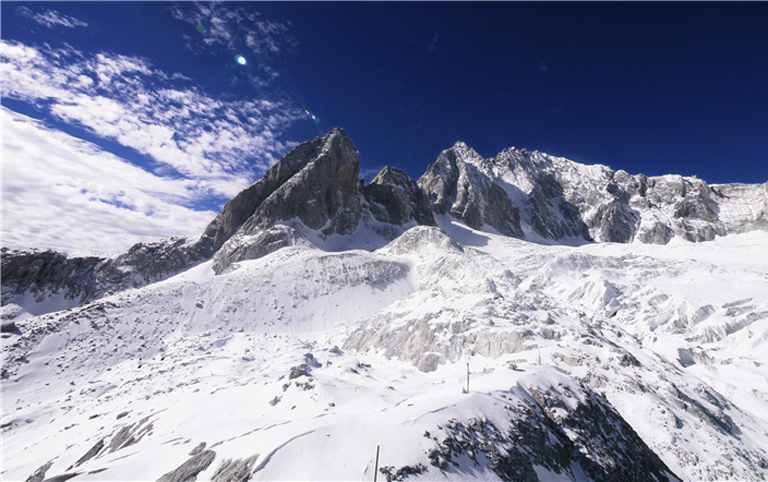 Magnificent Jade Dragon Snow Mountain
Magnificent Jade Dragon Snow Mountain
-
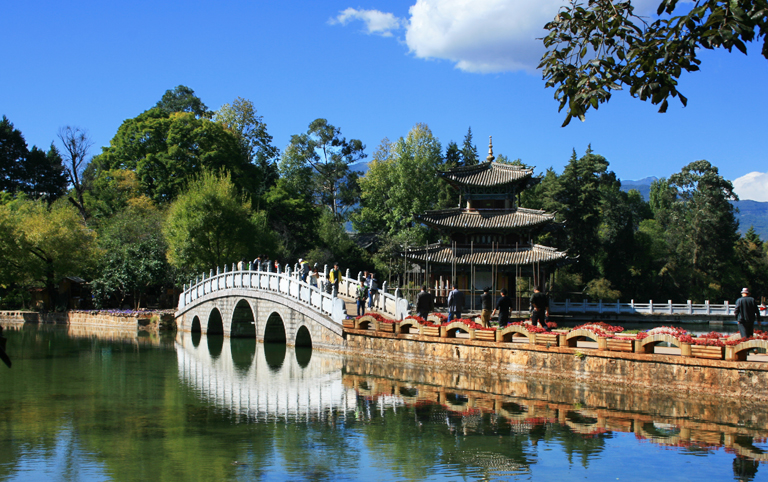 Gorgeous View and Peaceful Environment of Black Dragon Pool Park
Gorgeous View and Peaceful Environment of Black Dragon Pool Park
Day 4 Lijiang - Shangri-La ( B )
Today you’ll be driven to the old town of Shigu (Stone Drum) which is famed for a drum-like stele made by white marble. It enjoys high strategic and traffic significance in China’s history that many troops struggled for. You will take a visit to the Iron Chain Bridge which the Red Army used to cross the river during the Long March in 1930s. Then head to the stunning First Bend of the Yangtze River. Here you can witness the three rivers (Yangtze River, Lancang River and Nu River) traversing through the valleys of Hengduan Ranges, and forming this breathtaking view.
The last place of Lijiang to visit is marvelous Tiger Leaping Gorge - one of the deepest gorge and one of the ten most classic trekking trails in the world. Legend says that it is named after a courageous tiger who jumped across the rushing river to escape from a hunter. Take a little challenging trek to stretch your legs as well as glut your eyes with most naturally picturesque and distinctive landscape.
Later, you’ll drive about 100km to Shangri La. You’ll enjoy the enchanting natural scenes on the way.
Tips: 1) prepare comfortable strong walking shoes, light shirts and warm jackets; 2) bring sun creams to protect you from sunlight; 3) pack with enough water.
-
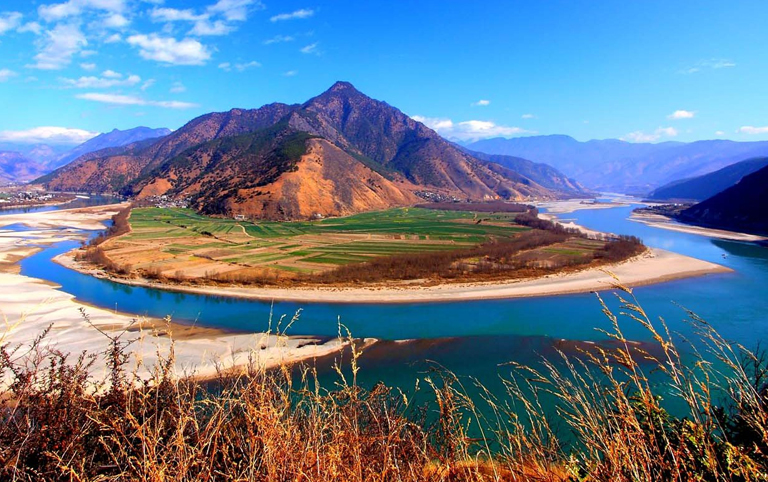 Extraordinary Turn with Marvelous Views
Extraordinary Turn with Marvelous Views
-
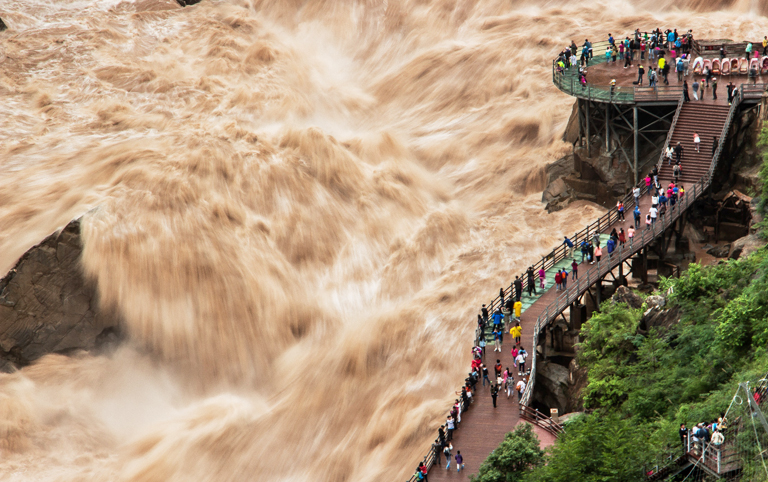 Stupendous Landscape of Tiger Leaping Gorge
Stupendous Landscape of Tiger Leaping Gorge
Day 5 Shangri-La ( B )
Firstly described in the well-known novel Lost Horizon by James Hilton, Shangri-La is a permanently joyous paradise isolated from the earthly world. The people live happily and contently there. Today, you will have a full day to explore its mystery and beauteousness.
After breakfast, pay a visit to the Songzanlin Lamasery – the largest Tibetan Buddhist lamasery in Yunnan. It is reputed as “Little Potala Palace” for its faithful imitation of the Potala Palace. In addition to perfect pattern of architecture, Songzanlin Lamasery also offers fine murals and magnificent Buddhist statues. While prayer flags are fluttering and the bells are tinkling, you will get an otherworldly peace of mind in the lamasery and understand how the simple Tibetan keeps their pure and religious belief in this temporal world.
Later you will drive to Potatso National Park and intoxicate yourself with the primitive landscape, including wetland, meadow and rare flora and fauna. Take a leisurely walk beside the beautiful Bitahai which is the highest lake in Yunnan Province. With captivating snow-mountain, green forest and bluish sky reflected in the water, Bitahai looks like a magical mirror. After feasting on the good views, walk to Shudu Lake where you can see scads many flocks and herds grazing in the field.
In the evening, pay a visit to a local Tibetan family and experience the highly-praised hospitality of Tibetan people.
Tips: 1) dress modestly, behave with good manner and ask for permission if you want to take pictures of monks or pilgrims; 2) the altitude of Bitahai is 3,538m, and avoid strong activity to avoid high altitude sickness; 3) you can choose to take a boat sailing on Bitahai or Shudu Lake for a more relaxed sightseeing.
-
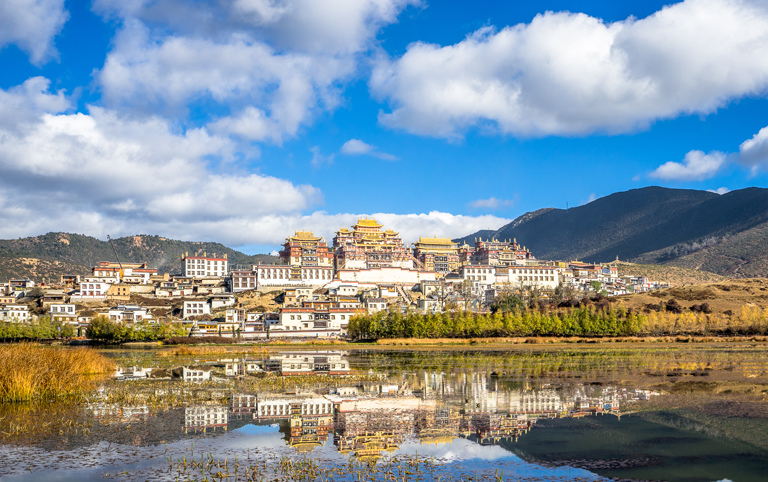 Songzanlin Lamasery - "little Potala Palace"
Songzanlin Lamasery - "little Potala Palace"
-
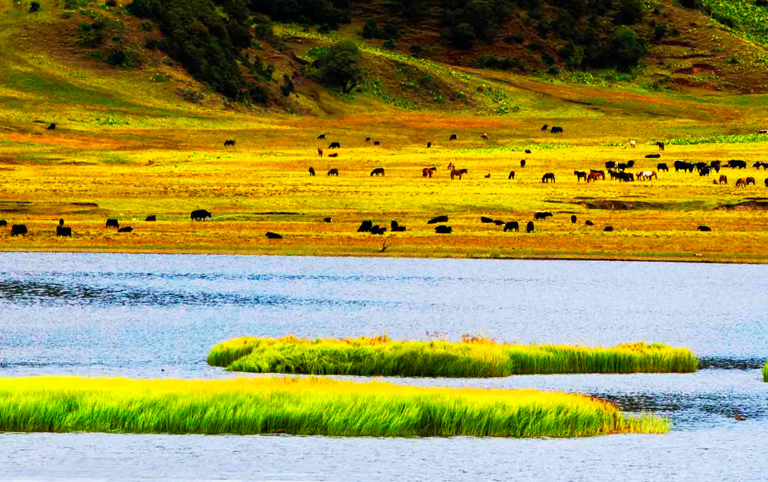 Many flocks and herds are grazing around Shudu Lake
Many flocks and herds are grazing around Shudu Lake
-
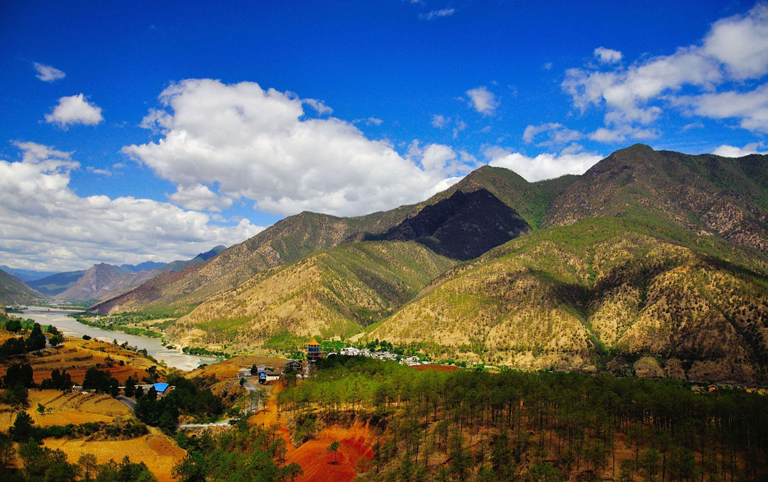 Poetic view of Potatso National Park
Poetic view of Potatso National Park
Day 6 Shangri-La - Lhasa ( B )
After breakfast, your local guide escorts you to the airport for your flight to Lhasa (about 2 hours flight). Remember to look out the window! Along the way you'll be treated to breathtaking views of Tibet's snow-capped mountains.
Welcome to the roof of the world! You will be picked up by local tour guide at the airport hall or train station, then be escorted to your hotel in Lhasa city in a private vehicle.
After arrival at your hotel, the rest of the day is free for you to explore the local areas and acclimatize yourself to the air, temperature and high altitude of Lhasa.
High Altitude Acclimation Tips:1) go for some leisure walking to acclimate the high altitude but avoid strenuous activity after arrival; 2) you'd better not have bath, in case of catching a cold; 3) drink more water, and have some fruit; 4) have a good rest...
Day 7 Lhasa ( B )
Start today’s Lhasa exploration with an exciting visit to the landmark - Potala Palace which is regarded as one of the most beautiful architectural building in the world. You will climb up the palace along the zigzag stone paths with white-and-red walls to the top of the palace where you can not only appreciate the exotic Tibetan-style architecture, but also get a great view of Lhasa’s urban areas, then walk into the inner space of Potala Palace to explore the stately chapels and learn about the history of the palace.
Continuing your exploration, you will then get to Jokhang Templewhich is considered as the spiritual heart of Tibetan Buddhism. Each day, there are thousands of pilgrims coming from different places in Tibet to the temple to worship to the Buddha. This temple is also known as the “house of Buddha” because it keeps the precious Jowo Rinpoche, the life-sized (5 foot/1.5m) image of the Shakyamuni at the age of 12. The last site for today’s exploration is the famous Barkor Street. It is a circular and wide street encircling the Jokhang Temple. The local people like to walk on the street for several circles usually in the late afternoon as a daily tradition of pilgrimage. The street also has many shops selling a wide variety of traditional Tibetan goods, religious items and handcrafts.
Tips of today: 1) there are 1,080 steps up to climb to the top of Potala Palace, so don’t walk in a rush, which may cause high altitude sickness; 2) taking photos is not allowed inside the palace; 3) today you will be mainly outside, please bring some water, a hat, sun cream, and sun glasses with you.
-
 Golden Roof of Jokhang Temple - Sabine
Golden Roof of Jokhang Temple - Sabine
-
 An Interesting Souvenir Shop at Barkhor Street
An Interesting Souvenir Shop at Barkhor Street
-
 Amazing Potala Palace in the morning
Amazing Potala Palace in the morning
Day 8 Lhasa ( B )
After breakfast, you will firstly go to visit the beautiful Norbulingka which used to be the former summer palace of Dalai Lamas in the ancient time, and now is a public park. It is famous for its Potrang, the private palaces of former Dalai lamas with grandiose Tibetan architecture style. Next, drive several kilometers to the western outskirts of Lhasa to visit Drepung Monastery. Drepung, in Tibetan, means “prosperity”. Since its establishment, Drepung Monastery has always been one of the most important Buddhist monasteries in Tibet. In its heyday, there were more than 10,000 monks lived and studied in the monastery. Throughout its history, many important and famous Tibetan leaders used to study here, especially the Dalai Lamas. So Drepung Monastery is also respectfully known as the “Mother School of Dalai Lamas”.
In the afternoon, you will be taken to another famous monastery in Lhasa - Sera Monastery. It is famous for the spectacular “Buddhism Debating”. As a daily routine, the monks gather in a courtyard, and debate on the Buddhist doctrines with supplemented gestures, which is thought to be helpful to facilitates better comprehension of the Buddhist philosophy to attain higher levels of study. After enjoying the "Buddhism Debating", you will be transferred back to the city. The rest time is your own free time to rest.
The Etiquette of Visiting Monastery: 1) you shouldn’t wear short and uncover shoulders; 2) taking off your sunglasses and hat before entering the chapels; 3) taking photos is usually not allowed inside the chapels.
-
 Debating Monks
Debating Monks
-
 Norbulingka Summer Palace in October
Norbulingka Summer Palace in October
-
 Grand Buddha Exhibition in Drepung Monastery during Shoton Festival
Grand Buddha Exhibition in Drepung Monastery during Shoton Festival
Day 9 Lhasa – Gyantse - Shigatse ( B )
Today, you will leave Lhasa and drive about 8 hours to Shigatse, the second largest city in Tibet. It may be a long journey, but there are many things to do along the road. The first site you will reach is the holy Yamdrok Lake. As the largest fresh lake in the northern of the Himalaya Mountains, it spreads about 675 square meters from south to north, like an eardrop lying in the arms of snow-capped giant mountains. Viewing from a distance, you can see fertile pastures full of yaks and sheep, and some small Tibetan villages along the lakeshore. Keeping driving not so far from Yamdrok Lake, you will see the imposing Karola Glacier towering aloft on the right side of the road.
Continuing your trip, you will get to the historical city of Gyantse. Feel hungry? Have a good lunch in the town, then go to visit the mysterious Palcho Monastery. The monks and tradition of three important sects of Tibetan Buddhism - Sakyapa, Zhalupa and Gelukpa, peacefully coexist in this monastery. Its Kumbum, which is 35 meters high and has 76 small chapels with hundreds images of Kriyatantras , is believed to be the largest such structure in Tibet.
After the Gyantse sightseeing, keep drive about 3 hours, you will arrive at your hotel in Shigatse. Have a good rest!
Tips of today: 1) wear warm clothes to prevent from cold and wild; 2) pack some food and drinks with you because you will spend much time on the road.
-
 Charming Palcho Monastery
Charming Palcho Monastery
-
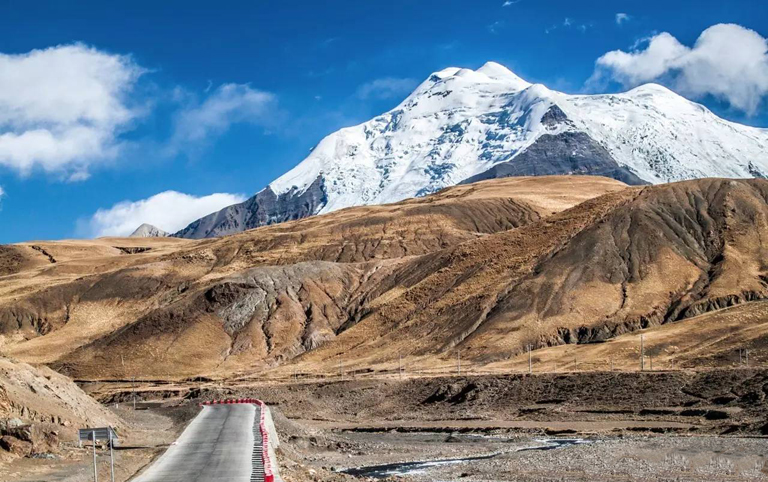 Karola Glaceier shines a brilliant white in the sunlight
Karola Glaceier shines a brilliant white in the sunlight
-
 Lake Yamdrok Yumtso with the view of Mt. Nojin Kangtsang
Lake Yamdrok Yumtso with the view of Mt. Nojin Kangtsang
Day 10 Shigatse - Tingri - Mount Everest ( B )
Today, before you driving Mount Everest, you will firstly take a visit to the official seat of Panchen Lama - Tashilhunpo Monastery which is also the largest and most influential Gelug Monastery in Shigatse prefecture. Here you will see a giant statue of Future Buddha, the largest one of its kind on earth ( 26.2 meters high and 11.5 meters wide ), decorated with precious pearls, turquoises, corals and ambers.
Then, you will leave Shigatse for the final destination of your Tibet trip - Mount Everest. Though being a long driving of about 7 hours, but the views along the road are stupendous. In clear days, you can see the clear face the Himalaya range including several famous peaks over 8,000 meters, such as Makalu, Lhotse, Gyachung and Cho Oyu. When you finally get to the Rongbuk Monastery, and get the first sight of the mighty Everest, you will immerse in a solemn ethereal mood and find all the efforts you have made along the long way are not in vain. Located about 5100 meters above the sea level, Rongbuk Monastery is the highest monastery in the world. It is the best location to take some great photos of the front face of Mount Everest. The rest of today is free for you to visit the Rongbuk Monastery and explore surrounding landscape.
Accommodation: if you visit Mount Everest during off season (November to April), you will accommodate at Rongbuk Guest House near the Rongbuk Monastery; if you visit Mount Everest during the peak season (May to October), you will accommodate at the Tibetan Tents Camp which is only run between May and October by local Tibetans. It is near Rongbuk Monastery as well. Please note that the accommodation at both places is very simple and basic, only dorm beds with communal squat toilets are available. Duvets, heated blankets and hot water will be provided, and you are suggested to bring your own sleeping bag and toilet paper. There is no running water, sinks or showers. The dining room just offer basic breakfast and dinner without menu. Remember to dress warmly all the time.
Tips of today: 1) currently Everest Base Camp is not open for tourists for environmental protection and the Everest landscape can be also enjoyed at Rongbuk Monastery - closest place to Mount Everest tourists can reach; 2) the vehicles and buses can only escort travelers to the Parking Lot which is about 20km away from Rongbuk Monastery, and then you need to take a 30 minutes' scenic park bus there; 3) the Everest altitude marker, a tablet reading "Mt. Qomolangma Elevation Measurement" has been transferred near Rongbuk Monastery and you can take a photo to commemorate your wonderful adventure tour; 4) bring a warm coat for low temperature in Everest and avoid strenuous activity to prevent from high altitude sickness.
-
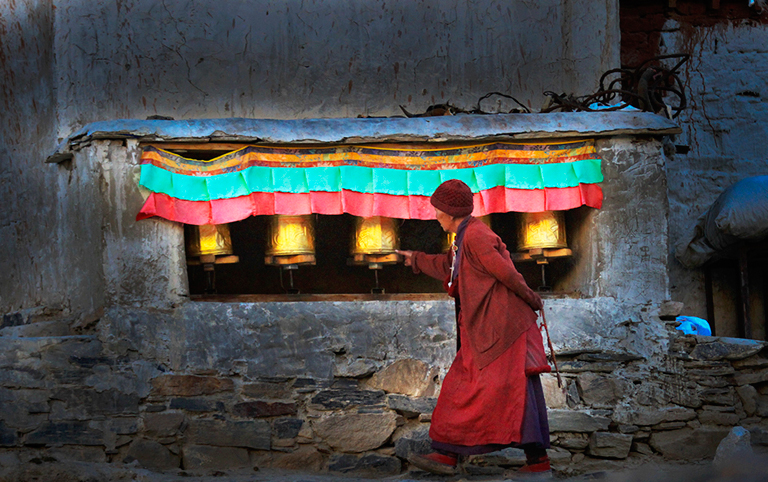 A devoted pilgrim in Rongbuk Monastery
A devoted pilgrim in Rongbuk Monastery
-
 Great view of Mount Everest from Rongbuk Monastery
Great view of Mount Everest from Rongbuk Monastery
Day 11 Everest Base - Gyirong ( B )
Wake up early to enjoy the marvelous sunrise on the peak of the world from Rongbuk Monastery. The top part of the Mount Everest is always covered by snow all the year round, and when the sun shines on the mountain, the peak is like a giant white pyramid, which is one of the most famous sceneries of Mount Everest. In bright days, you can also see a wisp of cloud hanging above the top of Mount Everest. It flies eastward in the fast western wind just like a flapping flag. This unique phenomenon is the spectacular “Cloud Flag”. The cloud will change from surging waves into a thin cooking smoke or from galloping steeds into the mysterious veil of a goddess.
Till now your Mount Everest adventure is about to end. The rest of today is to drive to Gyirong Town. The views along the road are stupendous. In clear days, you can see the clear face of Shishapangma Peak and enjoy the beautiful view of Pekutso Lake.
Accommodate at Gyirong Town.
Tips of today: 1) the sunrise usually starts around 6:30 am to 7am on Mount Everest; 2) keep warm all the time.
-
 Mt. Everest - the Highest Mountain in the World
Mt. Everest - the Highest Mountain in the World
-
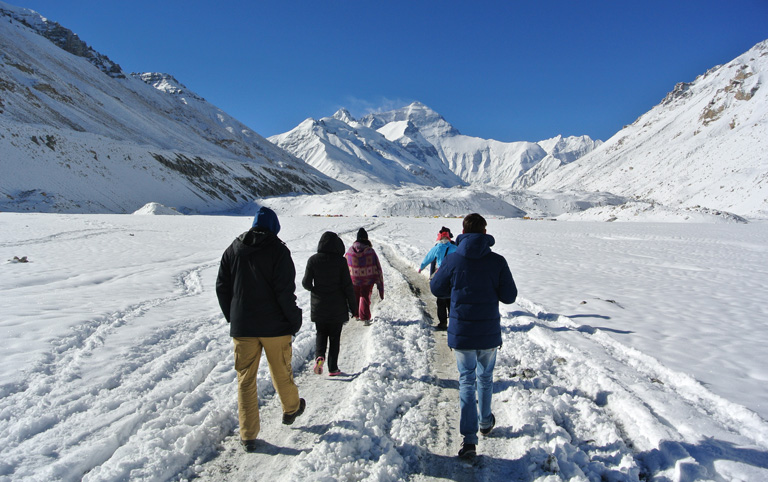 Mount Everest Base Camp Walking Around
Mount Everest Base Camp Walking Around
Day 12 Gyirong - Kathmandu ( B )
Today, you will leave the territory of Tibet. Drive about 25km to the Gyirong Port where you will walk across the custom to Nepal territory and transfer to Kathmandu. Tour ends.
Tips of today: 1) please pack your luggage carefully, especially for small things like camera charger, power adaptor, mobile phone, phone charger, wallet and towel; 2) Our service will end at the border of Tibet and Nepal. If you need private transfer from the border to Kathmandu, we can arrange for you with an extra charge.
Useful Trip Notes
Recommended Tibet Group Tour Packages
Escorted by a skilled driver and companied by a professional local tour guide to organize all the activities, all you have to do is to enjoy your fantastic Tibet journey.Following are some other recommended Tibet group tour packages that you may be interested in. You can also contact us to customize a trip if you want..
-

Lhasa / Gyantse / Shigatse / Everest / Lhasa
8 Days Lhasa to Mount Everest Private Tour
Highlights: Potala Palace, Yamdrok Lake, Tashilhunpo Monastery, Mt. Everest
-
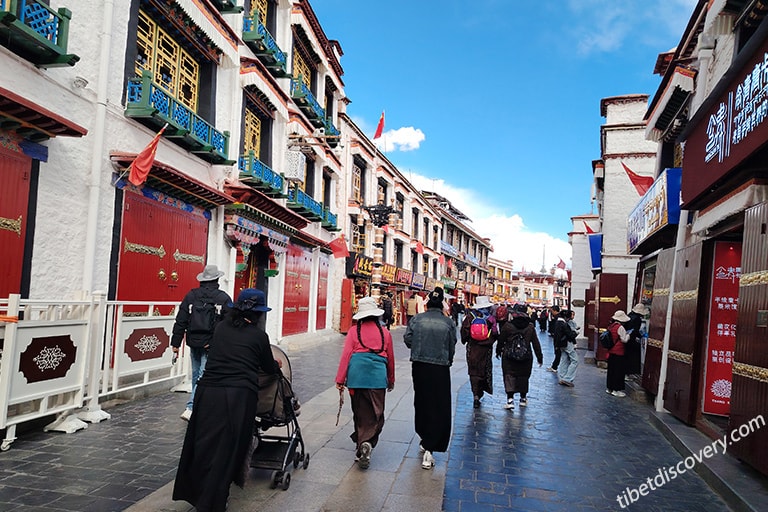
Lhasa city and suburb
5 Days Lhasa & Local Life Discovery Tour
Highlights: Potala Palace, Barkhor Street, Norbulingka Park, Tibetan Family Visiting
-

Lhasa / Gyantse / Shigatse / Lhasa
7 Days Lhasa Gyantse Shigatse Golden Triangle Tour
Highlights: Potala Palace, Yamdrok Lake, Tashilumpo Monastery, Mt. Everest







 Karen
Karen Wonder
Wonder Jack
Jack Rita
Rita Johnson
Johnson Vivien
Vivien Wing
Wing Ariel
Ariel Leo
Leo Tracy
Tracy Evelyn
Evelyn April
April Phoebe
Phoebe Kelly
Kelly Shirley
Shirley Reya
Reya Juliet
Juliet Elk
Elk Samantha
Samantha Felix
Felix Sean
Sean